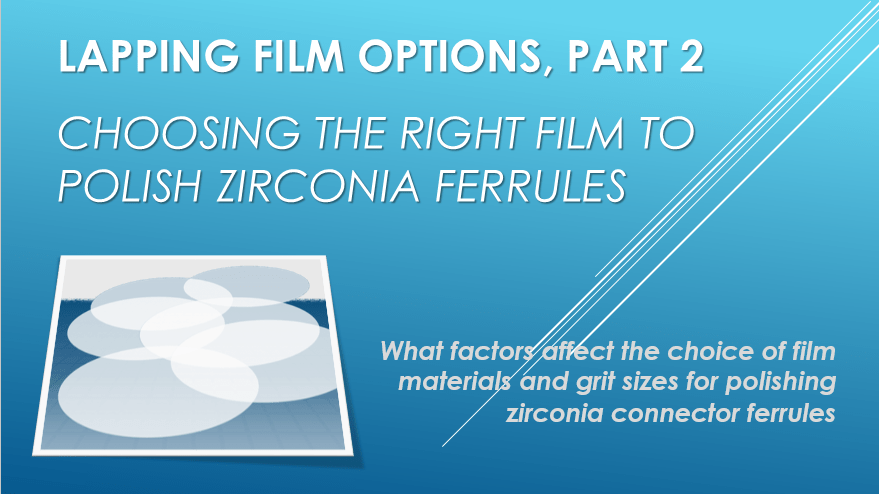Choosing the right film to polish zirconia ferrules
What factors affect the choice of film materials and grit sizes for polishing zirconia connector ferrules?
In Part 1 of this series we noted that FOC offers 476 items in its family of lapping-film products. This selection includes an array of abrasive materials and grit sizes. Which options make the most sense for you?
The answer depends on several questions:
- what are you polishing: ferrules, capillaries, waveguide devices, some other components?
- what is the material: alumina, fused silica, steel (various alloys), zirconia, other?
- what is the fiber type and fiber end (contact): S-M or MM? and PC, UPC, APC?
The film options differ for each of these polishing applications. This article will explore the requirements and film choices associated with zirconia ferrules, which are used with the following connector types: CS, FC, LC, MDC, MU, ST, SC , and others.
Zirconia ferrules have been used for almost 40 years, with the first ceramic ferrules introduced in 1980, in Japan.[i]< Since then, zirconia ferrules have become one of the fundamental building blocks of fiber-optic networks. When ceramic ferrules were first introduced, some connectors used alumina rather than zirconia. Over the years, however, zirconia has become the dominant choice for standard telecom and datacom connectors incorporating cylindrical ferrules.
The two main ferrule size categories are 1.25- and 2.5-mm outside diameter. There are options for inside diameter (hole size), outside diameter tolerance (for SM vs. MM), ferrule length, and end face (e.g., flat, radiused, and angle-polish tips). The last 30 years have seen several important trends in ferrule production. Monthly production quantities have increased by orders of magnitude. Prices have dropped more than tenfold. And with implications for the polishing process, ferrule-production processes have improved, resulting in consistently high-quality geometric and end-shape characteristics.

Three stages of polishing
Polishing has three main functions, achieved with three stages:
- removing residual epoxy, usually with a coarse-grit silicon carbide film;
- shaping the tip to achieve the correct geometric characteristics, usually with diamond film;
- final polishing, usually with silicon dioxide film, to remove scratches and achieve the appropriate “finish” on the fiber end while maintaining acceptable fiber-height dimensions.
Note that the above summary indicates the type of abrasive “usually” preferred with each stage. This describes the common practice, but there are multiple options. Some companies may use alternatives depending on specific size or material requirements, historical preferences, and other factors. For example, some assembly makers may use diamond films for epoxy removal, but this is not common. We also note that the shaping stage (2.) may involve multiple steps with two or more grits, progressing from coarser to finer.
Epoxy removal
This stage is necessary, but it does not require high precision. The goal is to remove epoxy and prepare the end for subsequent shaping, so it’s not necessary to use a finer grit. The choice of grit mainly depends on the size of the epoxy bead. For 2.5-mm ferrules, some have used 30-µm grit, but we typically recommend 16- or 9-µm options. For 1.25-mm ferrules, the options include 9-, 5-, or 3-µm. Silicon carbide generally is preferred.
Regardless of the grit, an important element in this step is cleaning the film to maximize its life. The film gets “gummed up” with epoxy residue and fails to “cut” with subsequent uses. We recommend isopropyl alcohol (IPA) in a solution of at least 90% IPA. Water is used during the polishing as a lubricant, but after the polishing, the film should be cleaned with IPA.
The goal is to minimize the time and cost relative to the amount of epoxy that must be removed. Most manufacturers aim to remove the epoxy with less than 60 seconds of polishing, sometimes as low as 15 or 20 seconds.
Shaping the ferrule
For this step, FOC recommends diamond film. Because diamond is the hardest material, it retains its cutting edge longer than other materials and therefore can be used to polish more pieces. Some ferrules, such as flat tips for multimode connectors, can be polished with aluminum oxide, but most assembly companies prefer diamond. It achieves better results with radiused ends and other ferrule geometries. As with stage-one epoxy removal, cleaning the film after each use will extend its life.
One question in this stage is how many grits to use. If the desired shape can be achieved with a 1-µm grit, it would be possible to use that for the entire shaping process. But this can take too long, depending on how much material needs to be removed. For example, a single-grit, say a 1-µm diamond film, might be used to polish some flat 1.25-mm ferrules, but this approach would take too long for radiused 2.5-mm ferrules. Most assembly makers use two grits for 2.5-mm ferrules, typically a 5-µm grit, followed by a 1-µm grit.
Generally, the zirconia ferrules supplied by the ferrule manufacturers have excellent geometric characteristics. After the fiber is cleaved and deburred, and after the epoxy is removed, the fiber end must be polished or “ground” to the correct height and profile relative to the ferrule. This polishing can alter the ferrule’s end shape as supplied. So part of the polishing process’s goal is to re-shape the ferrule and achieve the correct geometry with the fiber inside. This achieves the proper fiber-end-to-fiber-end interface when two connectors are mated.
Final polishing
The 1-µm diamond grits used in the previous stage will leave microscopic (about 1-µm-wide) grain marks on the glass fiber’s end-face. For multimode connectors, this finish quality may be acceptable, and further polishing is not necessary. For single-mode connectors, however, a final polishing step is needed to remove these grain marks. This final polishing results in optimum fiber surface quality and helps control the fiber height relative to the ferrule, thus helping achieve the specified return-loss and insertion-less performance.
This stage uses a single film with a silicon-dioxide abrasive. This material has proven very effective in achieving the correct “finish” on the fiber and controlling the fiber end’s index of refraction. The grit size is characterized as “sub-micron,” and the films generally are referred to as “final film.” The film manufacturers treat the details on the abrasive particles’ dimensions as proprietary information.
In this stage, then, the film’s target is the glass fiber end-face. The silicon-dioxide final film, with its fine and relatively soft particles, contributes minimally to any shaping or re-shaping of the zirconia ferrule. That is, stage two, typically ending with a 1-µm diamond film, is what gives the zirconia ferrule the shape needed for the final connector assembly. Stage three literally gives the “finishing touches” for optimum optical characteristics and end-face geometry.



